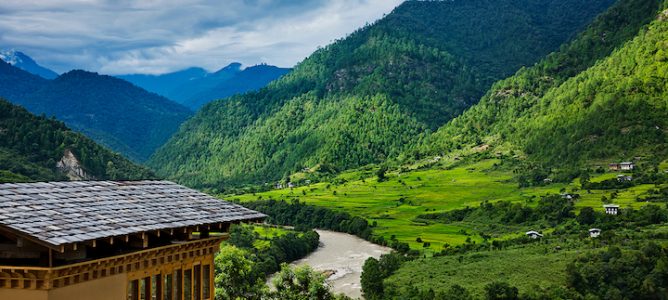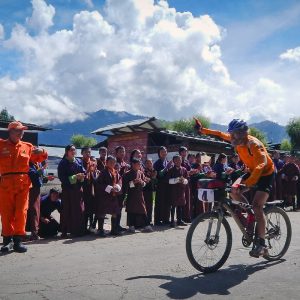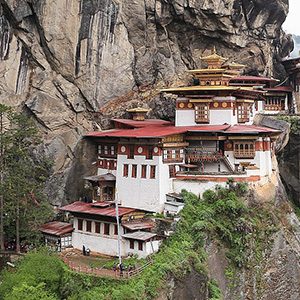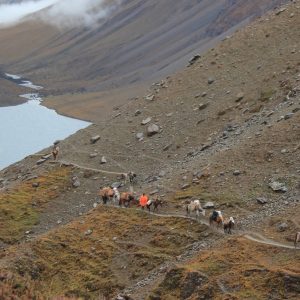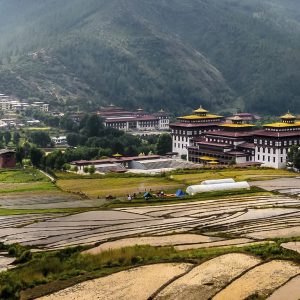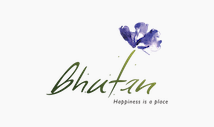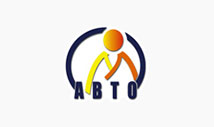Day 1: Guwahati – Samdrup Jongkhar –Trashigang
Arrive in Guwahati airport in Assam, India. Here you will meet your Bhutanese guide and driver, who will manage all immigration formalities and drive to Samdrup Jongkhar, a frontier town in southeastern Bhutan (3hrs). Along the way, you will pass through many rural towns of Assam, tea estates and rice-fields. Enter Bhutan and stroll around small township of Samdrup Jongkhar.
Then you will start all day drive ascending to the Himalayas. After few hours drive we will stop to get blessing from Hindu hermit for safety of our journey. Soon after you will have opportunity to visit first of many charming Bhutanese Buddhist temples, called Zangto Pelri Lhakhang, with detailed mural painting. During afternoon you will stop in Khaling village to visit National Handloom Development Project, which maintains rich tradition of local weaving. Also you will pay a visit to the National Institute for the Visually Impaired. One of the accomplishment of this progressive institution is the development of Bhutanese version of Braille’s script. Along the way, you’ll also pass by Karma Thegsum Dechenling Goemba, huge monastery school and Sherubtse College, first Bhutanese university campus established in 1978. Also we visit temple in nearby Kanglung village.
Overnight in Trashigang.
Day 2: Trashigang – Day Excursion to TashiYangtse
Morning visit of Trashigang Dzong which was built in 17th century and has commanding view of the valley. Inside are few interesting temples and local government offices. After that you’ll take about 2 hours drive time to TrashiYangtse. On the way, pay a visit to the GomKora temple, place where 8th century magician-saint Guru Padmasambhava left his body imprints. Further drive will offer occasional views of snowy mountain in clear weather. Finally you will see impressive building of the old TrashiYangtse Dzong which is home to 300 monks. The dzong used to protect former trade route with Tibet and was established by the saint Pema Lingpa of 15th century. Near the TrashiYangtse is the famous Chorten Kora, the largest stupa in Bhutan built in Nepali style.
This is the site of two colourful local festivals at the beginning of the year. TrashiYangtse is also home to National Institute for Zorig Chusum, the school where the young people learns the art crafts of their forefathers to keep Bhutan’s traditional arts alive. In winter, if time permits, it’s also good idea to make detour to Bumdeling birds reserve further to the north as the rare Black Neck Cranes might be spotted here if you’re lucky.
Evening return to Trashigang
Day 3: Trashigang to Merak
From Trashigang, a short drive brings you to Ranjung (small town). Continue up the hill with terraced rice paddies to Radhi village, from where new cut dirt farm road starts towards Chaling village and continuing on, road snakes uphill towards Shaktimi meadow, with yaks and sheep grazing with some yak herders’ huts scattered on the hillside. Continue the climb to reach Mendula Pass at 3345m. After the pass, it is downhill through the rhododendron forests, and meadows of Donmongchu by the river at 3145m. The dusty, rocky farm road continues up the valley, gradually gaining height through the rhododendron forests and shrubs and arrive at the first village Gangu (3430m) and and 15 minutes later arrive in large Merak village located at an altitude of 3520m.
Overnight in tent camp, Home Stay or local Guest House as available.(Approx 6 hrs drive).
Day 4: Merak
We have a full day to explore Merak. Visit the local village homes, meet with its local people. Merak is one of the most isolated valleys in Bhutan. Like the people of Sakteng, Merak people (Brokpas) are said to have migrated here few centuries ago from the Tshona region of southern Tibet. They arrived here after several months of journey across treacherous passes, set the shrubs on fire and settled down to make it their home called Merak, which literally means “Set on fire”. The inhabitants of Merak are similar to those of Sakteng in their language, dress, lifestyle and spiritual affiliation. However the people from Merak are said to be better built and taller than their counterparts in Sakteng. The houses are built of stones with very small windows and in most cases the houses are one storied only. In Merak the custom of polyandry is practiced, with brothers sharing the same wife.
Overnight in Merak village
Day 5: Merak to Trashigang
In the morning undertake short morning hike above the village to get beautiful views of the village and AumYomo peak. Later after telling goodbye to your hosts in Merak village, take a Bolero again and drive back to Trashigang.
Day 6: Trashigang – Mongar
It’s just 3½ hours drive to Mongar but it would be a pity not to make a 2 hours detour to Dramtse Gompa, which is one of the most important monasteries of eastern Bhutan. This is the place from where the famous Naga Chham (Drums of Dramtse), mask dance with drums originated. This dance is ubiquitous feature of many festivals and also it was included to the UNESCO list of of oral and intangible heritage. This monastery was founded in 16th century by descendants of the saint Pema Lingpa and it’s name means “the peak where there is no enemy”. There is number of interesting chapels with a lot of important statues of the saints and protector deities. If you’re in mood for short hike, you can also pursue 1.5 hour scenic hike from Dramtse to Bagingla via Shergang village. After reaching Mongar, you will pay a visit to it’s Dzong (castle). Although built in 1930, the dzong maintains Bhutanese architectural traditions.
Day 7: Mongar-Lhuntse
(Visit Tangmachu & Takila, Lhuentse Dzong and Gangzur pottery)
Morning drive to Lhuntse which is one of the most rural and isolated districts in Bhutan. The landscape is spectacular with stark cliffs and gorges, beautiful conifer and pine forests and remote villages with rice, millet and corn fields.
Kurtoe region of Lhuntse is the ancestral home of Bhutan’s royal family. On the way, we will make a detour to Takeyla, the place where the gigantic statue of Guru Rinpoche was recently built.Further you will continue to Khoma village to see the finest hand woven traditional clothes.
Village itself is interesting and beautiful so we will spend some extra time here having a lunch in local house and tasting local delicacies. Then we will continue to Lhuntse to see a dzong which is one of the most spectacular monastery / castles in Bhutan.
Drive back to Mongar
Day 8: Mongar-Bumthang
Begin a spectacular drive to central Bumthang, across Thrumshingla National park, through ever changing vegetation and landscapes, rich in bird and other wildlife. We also pass through many small hamlets and villages along the way and we will stop to visit few of them, arriving in Jakar by afternoon.
Overnight in hotel in Bumthang
Day 9: Bumthang
Bumthang is justifiably regarded as the cultural heartland of the kingdom with its many temples, holy sites, languages and traditions. We spend the full day in and around Jakar visiting its important monuments and cultural sites and local villages
Day 10: Bumthang
Drive to Tang valley and hike to Ugyen Choling palace which hosts wonderful private museum with carefully selected artifacts used in medieval Bhutan for various activities. If you feel strong, you can climb to Kundongdark gomba overlooking valley from sheer cliff. Otherwise you can visit nunnery, hosting the Buddhist nuns of all ages. You should not miss so called “Burning lake” Membartso where the treasure of scriptures hidden here by magician-saint Guru Rinpoche were discovered by saint Pema Lingpa
Day 11: Bumthang to Gangtey
After breakfast, begin a long drive to Gangtey. From Jakar, cross into Chumey valley, then across Yontongla pass, we arrive in Trongsa, where we stop to peek at the impressive Trongsa Dzong(fortress/monastery). Traverse Pele la pass (through Black mountain national park). On arrival in Gangtey you will join the monks for the evening prayer ceremony to pray for world peace.
Overnight in Gangtey.
Day 12:Gangtey
After breakfast visit Gangtey Monastery to watch Gangtey Tshechu.(Festival). Festivals in the Land of the Thunder Dragon are rich and happy expressions of its ancient Buddhist culture. These festivals are held in all districts in honour of Guru Rinpoche, the saint who introduced Buddhism to Bhutan in the 8th century. Tsechu’s are held on auspicious days and months in the Bhutanese calendar, and last up to four days in which a series of masked dance rituals are performed.
Festivals are also a big family and social occasions. People dress up in their finest clothes and most resplendent jewelry of coral and turquoise. They pack picnic lunches in their traditional bamboo baskets and stay all day at the festival.
Behind the scenes, the monks prepare themselves for weeks ahead of the festival, involved in deep prayer and meditation prior to the festival. The monks perform special masked dances that are inspirations of enlightened beings in history; and the Bhutanese believe that watching these mystical dances is essential to gain enlightenment.
After lunch hike through Gangtey Nature Trail and explore this beautiful valley.
Day 13: Gangtey – Punakha – Thimphu
After breakfast drive to Punakha, in Punakha visit Punakha Dzong, a former winter capital of Bhutan, located at the confluence of two rivers. Then drive up to Dochula pass, where we stop for lunch and to get the panoramic mountain views of eastern Himalayan peaks (weather permitting). After arrival in Thimphu, visit some of the attractions of the capital, including the great Tashichho Dzong, which is the main seat of the Government.
Overnight in Thimphu
Day 14:Thimphu-Paro
After lunch take ashort drive of about 1hr. and spend the full day around charming Paro valley, where we visit National Museum, Rinphung Dzong and beautiful 7th century Kichu Lhakhang temple, Dumtse Lhakhang, Dzondrakha cave temples and local farm houses by short walks and drives.
Overnight in hotel
Day 15:Paro – Hike to Tiger’s Nest
No journey to Bhutan is complete without a visit to Taktsang monastery. Drive short distance from the hotel to the trail-head and climb for about 2-3hrs to legendary Taktsang (Tiger’s nest) monastery. Option to hire riding horse for part of the way is available. Return to Paro for any remaining tour or stroll around the town area. Farewell dinner.
Overnight in Paro
Day 16: Depart Bhutan
Depart Bhutan.

